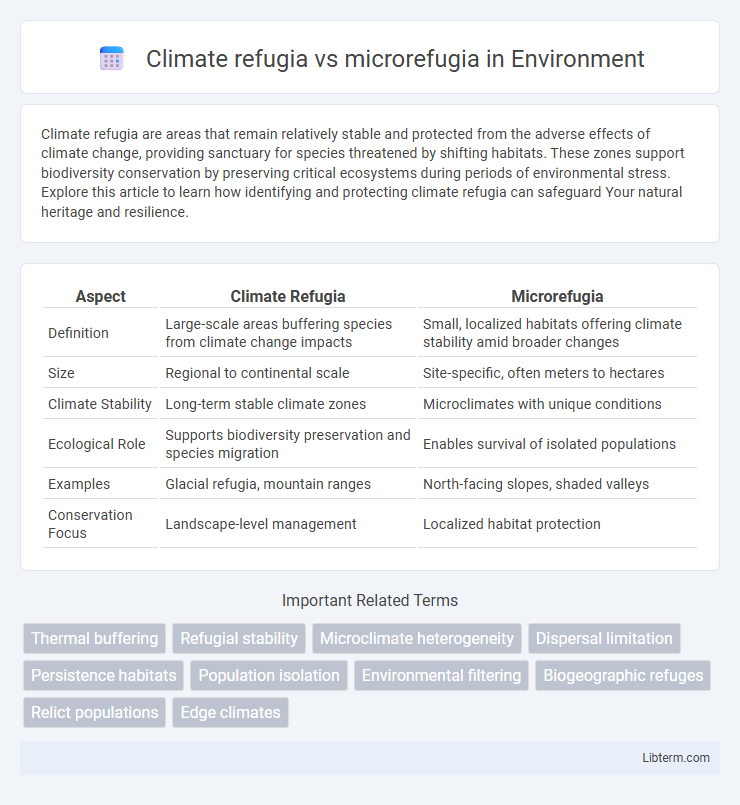Climate refugia are areas that remain relatively stable and protected from the adverse effects of climate change, providing sanctuary for species threatened by shifting habitats. These zones support biodiversity conservation by preserving critical ecosystems during periods of environmental stress. Explore this article to learn how identifying and protecting climate refugia can safeguard Your natural heritage and resilience.
Table of Comparison
| Aspect | Climate Refugia | Microrefugia |
|---|---|---|
| Definition | Large-scale areas buffering species from climate change impacts | Small, localized habitats offering climate stability amid broader changes |
| Size | Regional to continental scale | Site-specific, often meters to hectares |
| Climate Stability | Long-term stable climate zones | Microclimates with unique conditions |
| Ecological Role | Supports biodiversity preservation and species migration | Enables survival of isolated populations |
| Examples | Glacial refugia, mountain ranges | North-facing slopes, shaded valleys |
| Conservation Focus | Landscape-level management | Localized habitat protection |
Defining Climate Refugia and Microrefugia
Climate refugia are larger, stable geographic areas that provide long-term protection for species and ecosystems against climate change by maintaining suitable environmental conditions. Microrefugia refer to smaller, localized spots with unique microclimates that allow species to survive despite broader regional climate shifts. Both concepts are crucial for biodiversity conservation as they offer shelter during adverse climatic events.
Key Differences Between Climate Refugia and Microrefugia
Climate refugia are large-scale areas that provide stable environmental conditions allowing entire species or ecosystems to persist despite broader climate shifts, while microrefugia are small, localized habitats offering temporary shelter for individual populations or species within a heterogeneous landscape. Climate refugia typically sustain long-term biodiversity and ecological processes, whereas microrefugia serve as short-term holding areas facilitating species survival during climatic extremes. The spatial scale and duration of protection are key differences, with climate refugia encompassing broad regions over millennia and microrefugia limited to fine-scale patches over shorter timescales.
The Importance of Refugia in Biodiversity Conservation
Climate refugia are larger, stable areas that provide shelter for species during adverse climate changes, while microrefugia are smaller, localized habitats offering suitable conditions within otherwise inhospitable regions. Both types of refugia play a critical role in biodiversity conservation by preserving genetic diversity and enabling species persistence amidst environmental shifts. Protecting these habitats is essential for maintaining ecosystem resilience and facilitating species adaptation to ongoing climate change.
Geographic Scale: Macro versus Micro Refugia
Climate refugia refer to large-scale geographic areas that provide stable environmental conditions allowing species to survive during widespread climate changes. In contrast, microrefugia are small, localized habitats with unique microclimates that enable the persistence of species within a broader unsuitable landscape. The key difference lies in scale: climate refugia operate at macro-geographic levels spanning extensive regions, while microrefugia function at micro-geographic scales, often influenced by topography, soil, and vegetation heterogeneity.
Environmental Conditions and Drivers
Climate refugia are larger-scale areas with stable environmental conditions that buffer species from regional climate changes, characterized by factors such as topographic diversity and persistent moisture. Microrefugia are smaller, often localized spots where unique microclimates--created by features like north-facing slopes or groundwater input--allow species persistence despite surrounding unfavorable conditions. The primary environmental drivers for both include temperature stability, moisture availability, and landscape heterogeneity, which are critical in mitigating climate-induced stress on biodiversity.
Species Adaptation in Refugia Types
Species adaptation in climate refugia involves populations surviving broad, stable climatic conditions over large geographic areas, allowing genetic diversity to be maintained and evolutionary processes to proceed. In contrast, microrefugia offer small-scale, localized habitats with unique microclimates that enable species to persist during adverse macroclimatic shifts, promoting specialized adaptations and potential microevolutionary changes. Understanding the adaptive strategies in both refugia types is crucial for predicting species resilience and guiding conservation efforts under climate change scenarios.
Identifying and Mapping Refugia
Identifying and mapping climate refugia involve pinpointing large-scale areas that remain relatively stable despite regional climate changes, serving as long-term havens for biodiversity. Microrefugia are smaller, localized sites with unique microclimates that provide short-term shelter for species during extreme weather events or gradual shifts. Advanced GIS techniques and high-resolution climate models are essential tools for accurately delineating both refugia types, aiding conservation prioritization under global warming scenarios.
Refugia in the Context of Climate Change
Refugia in the context of climate change are critical habitats that provide shelter for species from adverse climatic conditions, ensuring biodiversity persistence. Climate refugia span larger geographic scales offering stable environmental conditions, while microrefugia are smaller, localized sites with unique microclimates that support species survival during rapid climate shifts. Identifying and protecting these refugia enhances conservation strategies to mitigate biodiversity loss under increasing global temperature and habitat fragmentation.
Conservation Strategies for Refugia Protection
Conservation strategies for refugia protection prioritize identifying and safeguarding climate refugia, which are larger-scale areas offering stable climate conditions that support species survival during environmental changes. Microrefugia, characterized by small, localized habitats with unique microclimates, require targeted management practices such as habitat restoration and connectivity enhancement to maintain genetic diversity and species persistence. Integrating landscape-level planning with fine-scale microhabitat conservation optimizes resilience against climate change impacts and ensures long-term biodiversity preservation.
Future Research Directions on Climate Refugia and Microrefugia
Future research on climate refugia and microrefugia should prioritize high-resolution spatial modeling to identify potential habitats that offer climatic stability under various climate change scenarios. Integrating genomic and ecological data will enhance understanding of species adaptation and resilience within these refugia, facilitating targeted conservation strategies. Developing standardized criteria and monitoring protocols will improve the detection, characterization, and management of both broad-scale climate refugia and fine-scale microrefugia.
Climate refugia Infographic

 libterm.com
libterm.com